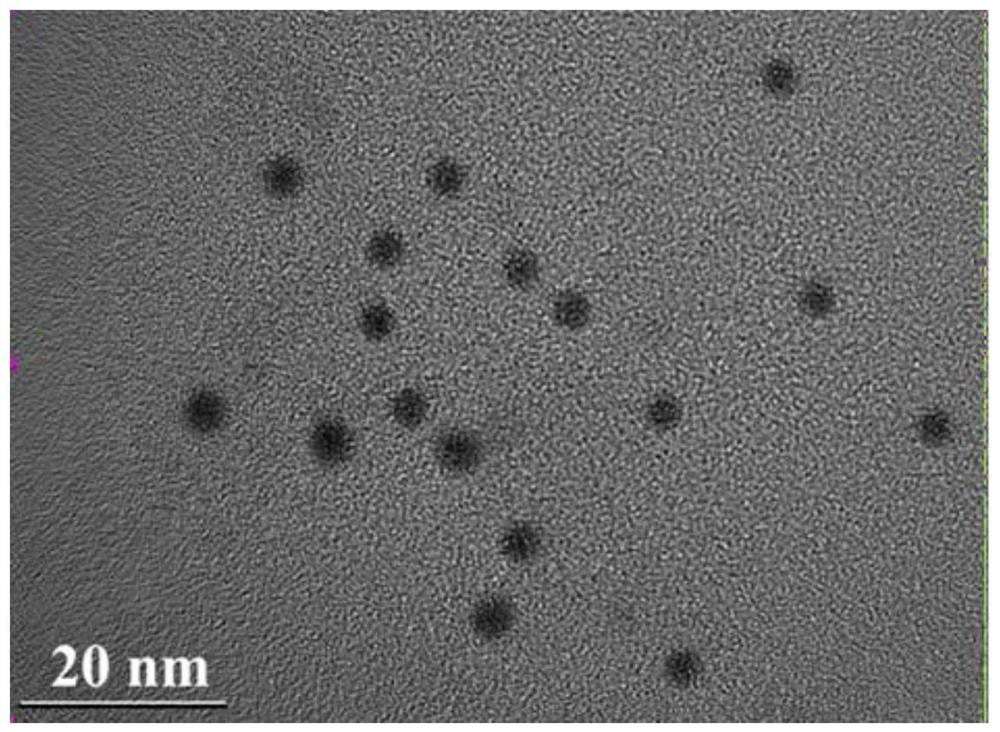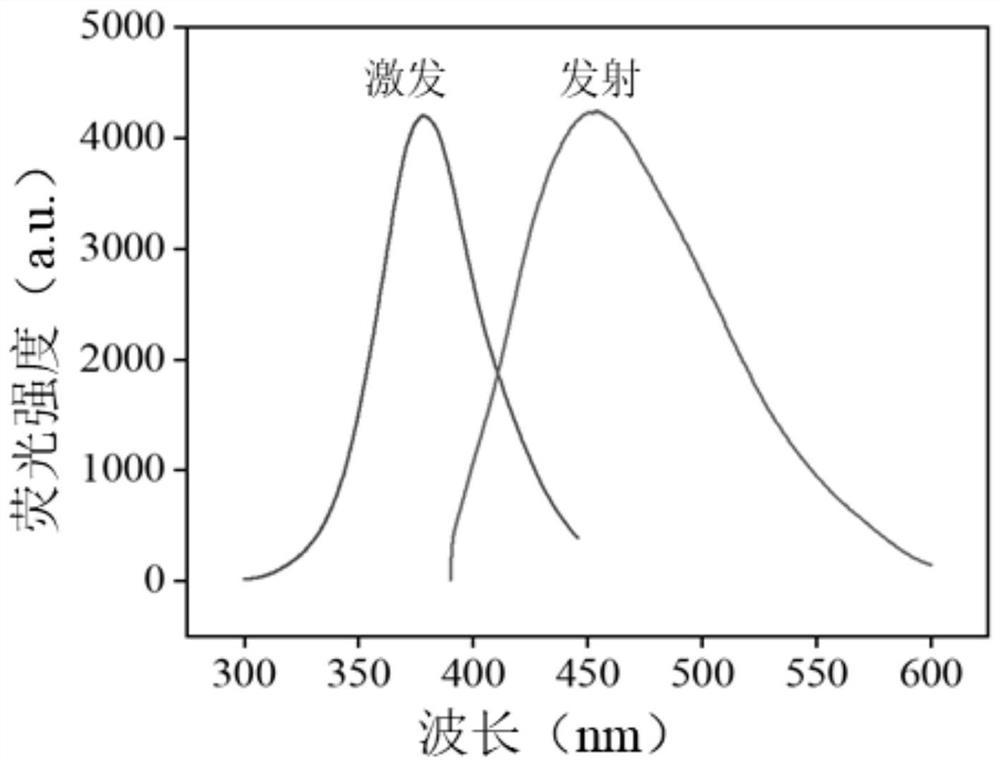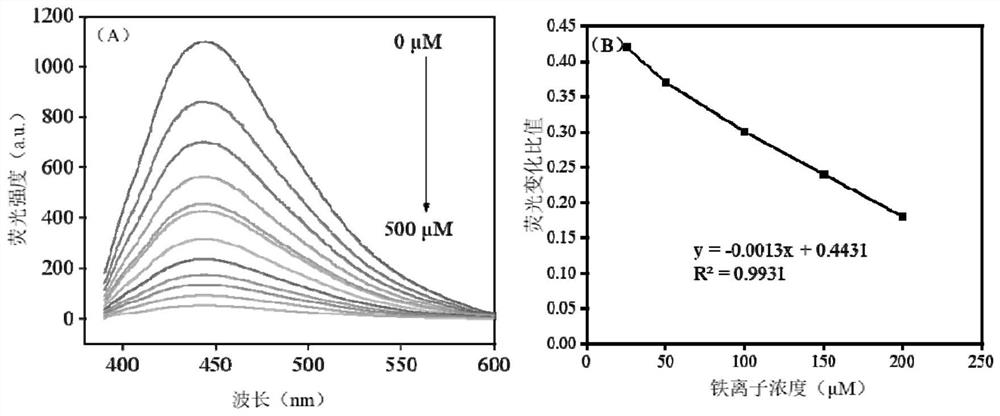Preparation method and application of beer-based nitrogen-phosphorus co-doped biomass carbon dots
A biomass carbon, co-doping technology, applied in chemical instruments and methods, nanocarbon, fluorescence/phosphorescence, etc., can solve the problems of increased operation and cost, detection performance disadvantage, etc., to achieve low cost, rich surface functional groups, fluorescence The effect of high intensity and fluorescence quantum yield
- Summary
- Abstract
- Description
- Claims
- Application Information
AI Technical Summary
Problems solved by technology
Method used
Image
Examples
Embodiment 1
[0047] This example provides a method for preparing beer-based nitrogen and phosphorus co-doped biomass carbon dots, specifically:
[0048] Get 100 milliliters of commercially available beer, filter the beer with a microporous membrane of 0.22 microns, and obtain the beer filtrate;
[0049] Take 50 ml of beer filtrate and add it to a Teflon-lined stainless steel autoclave. After sealing the autoclave, put it into a blast drying oven for hydrothermal carbonization at 160°C for 6 hours to obtain a light yellow solution, and cool it down to room temperature naturally. ;
[0050] Pass the light yellow solution through a 0.22-micron microporous membrane and centrifuge; the centrifuged supernatant is dialyzed in pure water for 12 hours with a molecular cut-off of 500 Da to obtain a dialysate;
[0051] The obtained dialysate was freeze-dried at -80°C to obtain powdered beer-based nitrogen and phosphorus co-doped biomass carbon dots.
[0052] see figure 1 , is the rendering of the ...
Embodiment 2
[0061] This example discloses the use of beer-based nitrogen and phosphorus co-doped biomass carbon points to detect Fe 3+ The method is specifically: adding 1 milliliter of beer-based nitrogen and phosphorus co-doped biomass carbon dot dialysate prepared in Example 2, and 300 microliters of phosphate buffered saline solution (concentration is 10 millimoles, pH value is 7.4), mix well;
[0062] Prepare Fe at a concentration of 0 to 400 micromolar per liter 3+ Several parts of the standard solution, the above mixed buffer solution was added to different concentrations of Fe 3+ Remove from the standard solution, shake well, and let it stand for 5 minutes;
[0063] For each standard solution, the fluorescence spectrum of the solution was measured, and the excitation wavelength was 370 nm.
[0064] image 3 for different concentrations of Fe 3+ Quenching effect of standard solution on fluorescence intensity of beer-based nitrogen and phosphorus co-doped biomass carbon dots. ...
Embodiment 3
[0066] This embodiment discloses a method for detecting ascorbic acid with beer-based nitrogen and phosphorus co-doped biomass carbon points, specifically:
[0067] Add 1 milliliter of the beer-based nitrogen and phosphorus co-doped biomass carbon point dialysate prepared in Example 2, and 300 microliters of phosphate buffered saline solution (concentration is 10 mmol, pH value is 7.4) to the centrifuge tube, and mix well;
[0068] Prepare Fe at a concentration of 0 to 500 micromolar per liter 3+ Several parts of the standard solution, as a fluorescence quencher, the above mixed buffer solution was added to different concentrations of Fe 3+ Remove from the standard solution, shake well, and let it stand for 5 minutes;
[0069] Prepare several parts of ascorbic acid standard solution with a concentration of 0 to 300 micromoles per liter as a fluorescence recovery agent. After the fluorescence quenching of beer-based nitrogen and phosphorus co-doped biomass carbon dots reaches ...
PUM
| Property | Measurement | Unit |
|---|---|---|
| Excitation wavelength | aaaaa | aaaaa |
Abstract
Description
Claims
Application Information
 Login to View More
Login to View More - Generate Ideas
- Intellectual Property
- Life Sciences
- Materials
- Tech Scout
- Unparalleled Data Quality
- Higher Quality Content
- 60% Fewer Hallucinations
Browse by: Latest US Patents, China's latest patents, Technical Efficacy Thesaurus, Application Domain, Technology Topic, Popular Technical Reports.
© 2025 PatSnap. All rights reserved.Legal|Privacy policy|Modern Slavery Act Transparency Statement|Sitemap|About US| Contact US: help@patsnap.com



